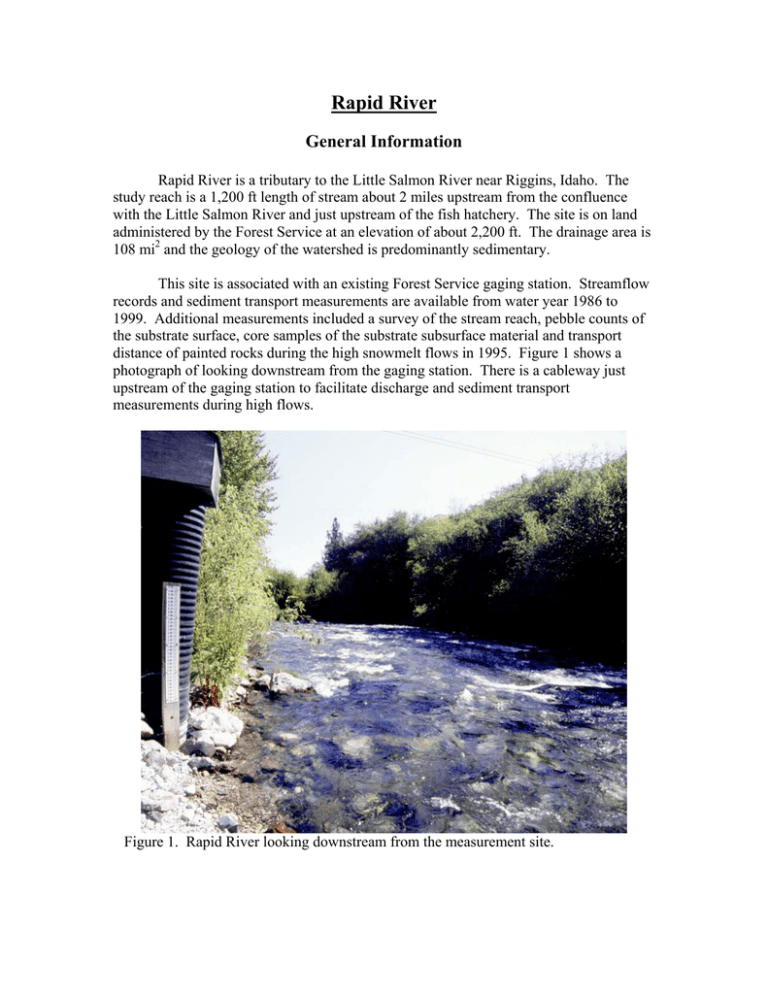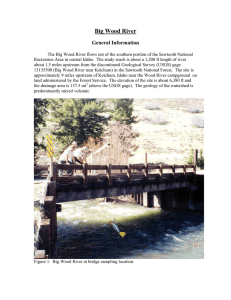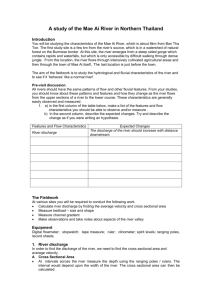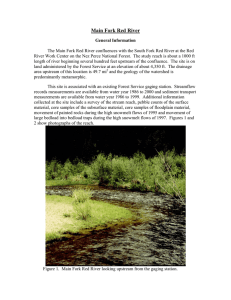Rapid River General Information
advertisement

Rapid River General Information Rapid River is a tributary to the Little Salmon River near Riggins, Idaho. The study reach is a 1,200 ft length of stream about 2 miles upstream from the confluence with the Little Salmon River and just upstream of the fish hatchery. The site is on land administered by the Forest Service at an elevation of about 2,200 ft. The drainage area is 108 mi2 and the geology of the watershed is predominantly sedimentary. This site is associated with an existing Forest Service gaging station. Streamflow records and sediment transport measurements are available from water year 1986 to 1999. Additional measurements included a survey of the stream reach, pebble counts of the substrate surface, core samples of the substrate subsurface material and transport distance of painted rocks during the high snowmelt flows in 1995. Figure 1 shows a photograph of looking downstream from the gaging station. There is a cableway just upstream of the gaging station to facilitate discharge and sediment transport measurements during high flows. Figure 1. Rapid River looking downstream from the measurement site. Streamflow was recorded for water years 1986 through 1999. Estimated average annual streamflow (Qa) for the stream is 162 ft3/s and the estimated bankfull discharge (Qb) is 626 ft3/s. Recorded stream discharge for this period ranged from 19.1 ft3/s to 1,357 ft3/s. The largest instantaneous discharge recorded was 1,450 ft3/s on May 31, 1986. Channel Profile and Cross-Section Figure 2 shows the longitudinal profile for the channel bed in the center of the channel, the water surface elevations along each bank at the time of the survey and bankfull flow elevations (floodplains). The average gradient for the study reach is 0.0108 ft/ft. Cross-sections of the channel were surveyed at seven locations. Discharge and sediment transport measurements were made at cross-section 1 (XS1) at the cableway and the movement of painted rocks during the spring and early summer snowmelt flows in 1995 were measured at two transects about 49 ft and 125 ft upstream of XS3. 170 Rapid River Elevation, ft 165 160 155 XS4 XS6 XS3 150 XS5 XS2 Water Surface Elevation Left Edge Water Surface Elevation Right Edge Center ofChannel Bed Elevation Bankfull Elevation Right Side 145 XS1 140 0 100 200 300 400 500 600 700 800 900 1000 1100 1200 1300 Distance, ft Figure 2. Longitudinal profile of the study reach in Rapid River. Elevation, ft 70 60 Rapid River 50 At Cableway 40 30 20 10 0 Qa 1998 survey -10 0 50 100 150 200 250 300 350 Distance, ft Figure 3. Cross-section of Rapid River at the cableway site. 400 450 500 Channel Geometry Figure 3 shows the cross-section at the sediment transport measurement site, cross-section 1. The channel geometry relationships for this cross-section are shown in Figure 4. All data collected during discharge measurements in 1986 through 1999 were used to develop the displayed power relationships with discharge (Figure 4). Over the range of discharges when sediment transport was measured (32.3 to 1,300 ft3/s) estimated stream width, estimated average depth and estimated average velocity varied from 42.2 to 65.9 ft, 0.72 to 2.74 ft, and 1.1 to 7.2 ft/s, respectively. The average reach gradient is 0.0108 ft/ft. 10 100 Average Velocity 0.516 y = 0.178x 2 R = 0.98 Top Width 0.121 y = 27.767x 2 R = 0.81 10 1 Average Depth 0.363 y = 0.203x 2 R = 0.94 0.1 10 100 1000 Average Velocity, ft/s Width and Depth, ft Rapid River 1 10000 Discharge, ft3/s Figure 4. Width, average depth and average velocity versus stream discharge at the measurement cross section on Rapid River. Channel Material A surface pebble count was made at cross-section 1 in July 1994. In October 1995 additional surface pebble counts were made at four cross-sections and four cores of subsurface material were collected. The average D50 and D90 for the 1994 pebble counts were 94 mm and 181 mm, respectively. The average D50 and D90 for the surface material in the reach in 1995 were 63 mm and 220 mm, respectively (Figure 5). The average D50 and D90 for the subsurface material (1995) were 16 mm and 113 mm, respectively. About 10% of the surface material is sand (2 mm) size or smaller. The particle size distribution of the floodplain surface strata was quite variable. The median diameter of the floodplain subsurface strata material was smaller than 0.25 mm. 100 Rapid River 90 80 Percent Finer 70 60 50 Floodplain Samples 40 30 20 Surface 1995 Subsurface 1995 Surface 1994 10 0 0.01 0.1 1 10 100 1000 Particle Size, mm Figure 5. Particle size distribution for surface and subsurface material samples and for floodplain material samples collected in Rapid River. Sediment Transport The bedload and suspended load measurements in water years 1986 through 2000 were all made in the vicinity of the cableway. The sediment transport data includes 191 measurements of bedload transport and 85 measurements of suspended sediment. Sediment transport measurements spanned a range of stream discharges from 32.3 ft3/s (0.20Qa; 0.05Qb) to 1,300 ft3/s (8.02Qa; 2.08Qb). Bedload transport ranged from 0.00270 to 465 t/d and suspended transport ranged from 0.05 to 1,919 t/d. Over the range of measured discharges, suspended transport accounts for the majority of the material in transport with approximately four fold difference at the lowest discharge and over an order of magnitude difference at the highest discharge (Figure 6). 10000 Rapid River Sediment Transport, tons/day 1000 100 10 Suspended 2.533 y = 4.587E-06x 2 R = 0.89 BCF=1.340 1 Total Bedload 2.233 y = 3.306E-06x 2 R = 0.59 BCF=2.594 0.1 0.01 0.001 Qb Qa Suspended Total Bedload 0.0001 1 10 100 1000 10000 3 Discharge, ft /s Figure 6. Bedload and suspended load transport rate versus discharge. The bedload transport rates by size class (Figure 7) shows that the larger rates are usually associated with material in the 0.5 to 2mm diameter size class. At the highest range of flows material larger than 32mm make up a larger portion of the material in transport. Twelve of the bedload samples contained material larger than 32 mm diameter all at discharges equal or greater than 346 ft3/s. 1000 <0.5mm 1.903 y = 4.078E-06x 2 R = 0.69 100 Bedload Rate, tons/day 10 Rapid River 1994 through 2000 0.5-2mm 2.009 y = 6.142E-06x 2 R = 0.69 1 2-8mm 2.081 y = 2.546E-06x 2 R = 0.59 0.1 0.01 8-32mm 1.886 y = 5.962E-06x 2 R = 0.48 0.001 >32mm 2.793 y = 5.656E-08x 2 R = 0.60 <0.5mm 0.5-2mm 2-8mm Qa 8-32mm Qb >32mm 0.0001 1 10 100 1000 Discharge, ft3/s Figure 7. Bedload transport rate versus discharge for selected size classes 10000 There was a trend of increasing size of the largest particle in the bedload sample with increasing discharge (Figure 8). The largest particle measured in the bedload sample was 62 mm at a discharge of 638 ft3/s. There was also a weak trend of increase median size of the bedload sample with increasing discharge. The largest median size of a sample was 37.2 mm at a discharge of 597 ft3/s. The information on the largest particle in the bedload sample and observations of painted rock movement and recently moved large particles suggest that discharges near bankfull discharge are capable of moving the median diameter particles on the channel surface. 1000 Rapid River Largest Painted Rock D50 for four surface pebble counts 100 Bedload Size, mm Largest Particle 1997 R2 = 0.42 D50 for four subsurface cores 10 R2 = 0.16 1 Qa Median Size Qb Largest Particle 0.1 1 10 100 1000 10000 Discharge, ft3/s Figure 8. Largest particle in the bedload sample and median size of the sample versus stream discharge for Rapid River. Painted Rock Transport A total of forty painted rocks were placed across two transects (twenty per transect) on April 18, 1995. Daily mean discharge on the day of rock placement was 127 ft3/s. The size of the rocks ranged from 73 to 180 mm diameter (b-axis) which represents the D53 up to the D83 of the surface particle size distribution for the reach. Transport of the rocks as of September 18, 1995 are shown in Figures 9 and 10. Travel Distance, ft 50 45 Rapid River 40 Painted Rocks Transect 1 35 The maximum instantaneous 3 discharge of 924 ft /s occurred on June 17, 1995. 30 25 Particle B-axis, mm 20 15 10 159 5 85 157 81 152 100 145 114 142 M M M M 28 30 32 34 M M 96 M M M 40 42 44 161 99 155 M 95 160 M 89 147 94 149 81 58 60 62 64 M 0 26 36 38 46 48 50 52 54 56 Distance across stream, ft Figure 9. Transport distance of painted rocks at transect 1. 100 Rapid River Painted Rocks 90 Travel Distance, ft 80 Transect 2 70 The maximum instantaneous 3 discharge of 924 ft /s occurred on June 17, 1995. 60 50 40 Particle B-axis, mm 30 20 154 10 85 135 92 132 81 155 90 155 73 M M M M M M M M M 31.5 34 36.5 39 41.5 44 46.5 49 51.5 137 75 180 105 135 M M M 61.5 64 85 129 102 M 77 140 M 0 29 54 56.5 59 Distance across stream, ft Figure 10 Transport distance of painted rocks at transect 2. 66.5 69 71.5 74 76.5 Fourteen of the forty rocks were found. Of those found, only two had not moved. The maximum transport distance was 91 ft for a 137 mm diameter rock and the average was transport distance was 31.2 ft. The largest daily mean discharge during this period was 841 ft3/s on June 18, 1995 and the largest instantaneous discharge was 924 ft3/s on June 17, 1995.






